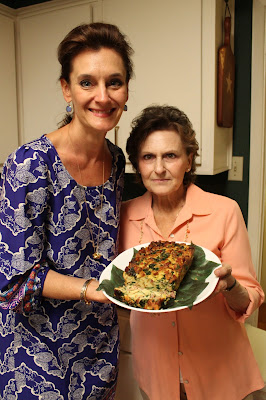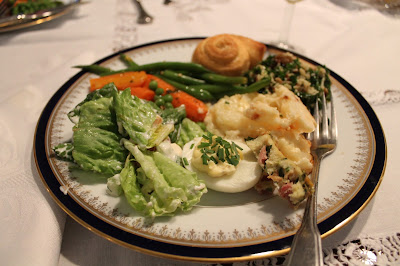
Easter has always been a holiday for which my immediate and even extended family gets together. My parents and six of their ten grandchildren are pictured at left on Easter Sunday last week. We have traditions around the day, from putting out baskets, of course, dyeing eggs, the Easter egg hunt for the kids, to some dishes my parents make every year, but nothing I've thought of as Czech. Our Easter celebration over the years has seemed a mix of Catholic and American activities and foods.
I've been divorced for years and spent many Easter weekends at my parent's house, where we would dye eggs together and the Easter Bunny would visit overnight. This year was the same with my youngest son asking to eat the candy out of his basket before I'd poured the cream in my coffee. But for the last few years, I've managed to bake mazanec (Czech Easter bread), which my Czech grandmother did not make. She did make vanocka (Czech Christmas bread) though, and the recipes are almost identical, so I say I'm reviving the tradition of baking mazanec. We had made the mazanec the night before, so I had something to get into my son quickly before the sugar hit his system. Process photos of the baking are below.
Nadivka is another dish that is traditional in the Czech Republic, but not served in Texas-Czech homes. At least, I've never heard of it being served or anyone that was familiar with it. My sister surprised us all by showing up with nadivka this year, a savory "present" she called it for me and my parents. It was delicious and understandably a perfect Easter breakfast or brunch dish with its eggs, bread cubes, and smoked ham (Christmas ham from the freezer! - we are resourceful Czechs and do not throw food away.) It was a like a strata or very dense quiche baked in a loaf pan. And, being the modern super woman my sister is, she connected with her cultural traditions by Googling. She found a story about the Czech food maven Hana Michopulu and followed it to this recipe for nadivka. Then she used bolillos for the bread cubes, because we are Texans, too, dang it! (Add another recipe to the Tex-Mex-Czech repertoire.) My parents and I decided nadivka would be our new Easter Sunday breakfast dish in the future, made the night before and baked in the morning while the kids are critiquing the Easter Bunny's gifts in their baskets.
My parents traditionally serve the following menu at our Easter lunch: smoked ham, asparagus or green beans, several other vegetable dishes that change year to year (this year peas with mushrooms, carrots with parsley, a layered green salad, and au gratin potatoes) and deviled eggs.
My family LOVES appetizers and usually laments how full we are before lunch is actually served (but never change our ways), so we had boiled shrimp with my dad's family-famous red sauce, a crudites platter, assorted cheeses and pâté, pickles and olives. My sister nodded to her husband's Greek heritage with basil pesto hummus and accommodated a vegetarian son with kale and quinoa salad.
Desserts included lemon bars, decorated sugar cookies, and my mom's Strawberry Devonshire Tart. The tart has nothing to do with our family heritage; my mom tore the recipe from a magazine in the late 1970s and has been making it to usher in spring ever since. It always works.
After lunch, there was much running through the house by the grandchildren and talking and drinking of mimosas and other drinks by the adults. Piles of dishes were washed. The hounds were released (i.e. Easter egg hunt in the backyard.) There was discussion of my mother's garden, the profusion of blossoms on the tangerine tree, and the fact that "Easter lilies" my mother had planted in her backyard, transplanted from her mother's yard, bloomed THAT morning.
We all Facetimed my nephew, away at college in Alabama, by passing the iPhone around the house. More treats were distributed by my mother as we left for home... a Godiva chocolate bunny with a $2 bill tied to his neck. This tradition comes from my grandmother who would give her grandchildren $2 bills at Easter. Why? I don't know, but I still have a few my grandmother gave me, and my sons have all of theirs.
I do find it a little strange that traditional Czech food is not a bigger part of our Easter menu. My mother's family had a very traditional Christmas menu, so I wonder why dishes didn't get passed down for Easter, too. But my grandmother had only 3/4 the number of children (8) that my great-grandmother Morkovsky did (11). My mother had only half the number of children that her mother had. And I had only half the number of children my mother had. Not so many people to get together and cook for (or have around to help.) My grandmother lived her entire adult life in Hallettsville, with a population around 2,500 (now) and brothers and sisters on farms in the surrounding counties, while my parents moved all over the country before settling in Houston. And two of my siblings live in a city of 4 million people while by brother and I live in Austin (will be 4 million people if we don't watch out.) And of course, my mother worked full-time for much of her adult life as do I, which my grandmother did not do. The socioeconomic factors of moving from rural to urban areas, women with full-time jobs, and having much smaller families have taken their toll on many Texas Czech cultural traditions.
But still, the picture below sums up for me the essence of what still remains and that I feel absolutely blessed to experience... CLOSE family with lots of multi-generational interaction. We play together and we work together (even if that's just to pull together a delicious Easter lunch and then get the dishes done.)
 |
| Mazanec dough rising. |
 |
| Buttering the dough balls. |
 |
| Finished mazanec with raisins and sliced almonds. |
I used The the mazanec recipe out of The Czech Book: Recipes and Traditions, compiled by Pat Martin. The recipe was from a Mrs. Frank J. Stastny of Cedar Rapids, Iowa. Apologies to Pat and Mrs. Stastny, but I was not happy with the recipe. The bread didn't rise like it should, which I think had something to do with the way the recipe directs you to proof the yeast. It still tasted delicious dipped in coffee, which is how my mother remembers eating vanocka on Christmas morning. And I made the recipe into six small loaves, so we could eat one and then send the others home with my siblings and parents.
 |
| My sister and mother. |
 |
| Nadivka using smoked ham and spinach. |
My family LOVES appetizers and usually laments how full we are before lunch is actually served (but never change our ways), so we had boiled shrimp with my dad's family-famous red sauce, a crudites platter, assorted cheeses and pâté, pickles and olives. My sister nodded to her husband's Greek heritage with basil pesto hummus and accommodated a vegetarian son with kale and quinoa salad.
 |
| First cousins! |
 |
| My niece, Emma, in my parents' backyard garden. |
 |
| Me and my son in my parents' backyard in Katy. |
I do find it a little strange that traditional Czech food is not a bigger part of our Easter menu. My mother's family had a very traditional Christmas menu, so I wonder why dishes didn't get passed down for Easter, too. But my grandmother had only 3/4 the number of children (8) that my great-grandmother Morkovsky did (11). My mother had only half the number of children that her mother had. And I had only half the number of children my mother had. Not so many people to get together and cook for (or have around to help.) My grandmother lived her entire adult life in Hallettsville, with a population around 2,500 (now) and brothers and sisters on farms in the surrounding counties, while my parents moved all over the country before settling in Houston. And two of my siblings live in a city of 4 million people while by brother and I live in Austin (will be 4 million people if we don't watch out.) And of course, my mother worked full-time for much of her adult life as do I, which my grandmother did not do. The socioeconomic factors of moving from rural to urban areas, women with full-time jobs, and having much smaller families have taken their toll on many Texas Czech cultural traditions.
But still, the picture below sums up for me the essence of what still remains and that I feel absolutely blessed to experience... CLOSE family with lots of multi-generational interaction. We play together and we work together (even if that's just to pull together a delicious Easter lunch and then get the dishes done.)
 |
| My son, sent flying by my brother, while our niece watches the shananigans. |



You captured our family Easter celebration beautifully. Thank you!
ReplyDelete